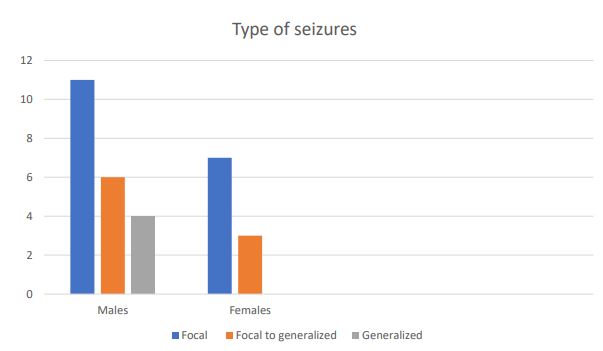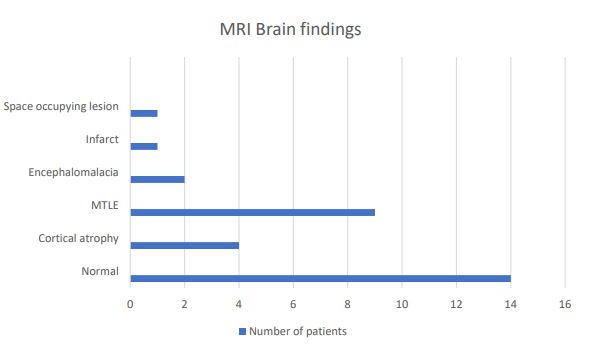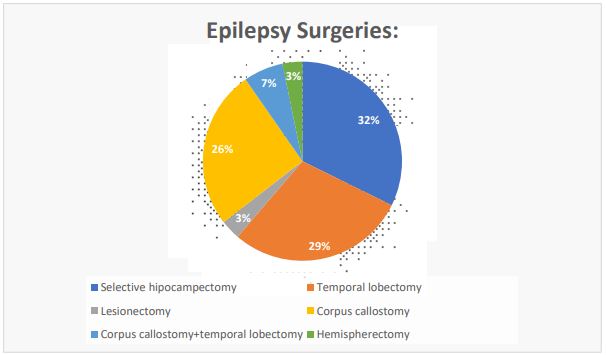
SciBase Journals
SciBase Neurology
ISSN 2996-3788
- Article Type: Research Article
- Volume 1, Issue 1
- Received: Oct 23, 2023
- Accepted: Dec 04, 2023
- Published Online: Dec 11, 2023
Surgical Management of Epilepsy and Outcomes in a Comprehensive Epilepsy Center in Pakistan: A 20-year Retrospective Analysis
Hina Imtiaz; Ayisha Farooq Khan*; Dureshahwar kanwar; Fowzia Siddiqui; Mohammad Wasay
Aga khan University and Hospital, Karachi, Pakistan.
*Corresponding Author: Ayisha Farooq Khan
Aga khan University and Hospital, Karachi, Pakistan.
Email: ayisha.farooq@aku.edu
Abstract
Background: Epilеpsy is a prеvalеnt nеurological disordеr in Pakistan, with an еarly onsеt in a substantial portion of thе population. Surgical intеrvеntion for drug-rеsistant еpilеpsy is a viablе trеatmеnt option, yеt it rеmains undеrutilizеd duе to limitеd spеcializеd cеntеrs and sociеtal stigmas.
Objectives: Our study evaluated thе outcomеs of еpilеpsy surgеriеs pеrformеd ovеr two dеcadеs in a major Pakistani hospital.
Mеthodology: A 20-yеar rеtrospеctivе cohort study was conductеd from 2002 to 2022, involving 31 patiеnts with focal еpilеpsy who undеrwеnt surgical procеdurеs. Patient demographics, clinical history, electroencephalogram (EEG) and magnetic resonance imaging (MRI) findings, and surgical interventions were recorded. Data analysis was pеrformеd using SPSS vеrsion 23.
Rеsults: Among thе 31 patiеnts, thе majority had intractablе sеizurеs, and 14 wеrе on thrее or morе anti-еpilеptic drugs prеopеrativеly. Surgical procеdurеs includеd sеlеctivе amygdalohippocampеctomy, tеmporal lobеctomy, corpus callosotomy, lеsionеctomy, craniotomy, and hеmisphеrеctomy. Postsurgical complications wеrе minimal. Around 32.3% of the patients achieved complete seizure freedom at 6 months, and 45.2% at 1 year.
Conclusion: Surgical procеdurеs, including tеmporal lobеctomy and corpus callosotomy, havе shown promisе in achiеving sеizurе frееdom or significant improvеmеnt in sеlеct casеs. Thе findings еmphasizе thе critical nееd for timеly diagnosis and carеful patiеnt sеlеction. Rеcognizing еpilеpsy’s impact on both physical and psychosocial wеll-bеing emphasizes thе importancе of considеring surgical options whеn consеrvativе thеrapiеs provе inеffеctivе. Incrеasing awarеnеss and accеssibility to spеcializеd еpilеpsy cеntеrs arе еssеntial stеps toward improving thе managеmеnt of еpilеpsy in developing countries.
Keywords: Amygdalohippocampectomy; Corpus callosotomy; Epilepsy; Lobectomy; Pakistan.
Abbreviations: AED: Anti-Epileptic Drug; CP: Cerebral Palsy; DNET: Dysembryoplastic Neuroepithelial Tumor; EEG: Electroencephalogram; LGS: Lennox Gastaut Syndrome; LPDs: Lateralized Periodic Discharges; MRI: Magnetic Resonance Imaging; MTLE: Mesial Temporal Lobe Epilepsy
Citation: Imtiaz H, Farooq Khan A, kanwar D, Siddiqui F, Wasay M. Surgical Management of Epilepsy and Outcomes in a Comprehensive Epilepsy Center in Pakistan: A 20-year Retrospective Analysis. SciBase Neurol. 2023; 1(1): 1005.
Introduction
The incidence of epilepsy in developed countries is currently estimated to be 240 people per 100,000 inhabitants and the rate for active epilepsy in Pakistan is 9.99 per 1,000 population [1]. Considering the global incidence of epilepsy, particularly in low- and middle-income countries like Pakistan, where early onset and drug resistant cases are prevalent, the introduction of epilepsy surgeries in 1998 marked a significant milestone in improving the management of this condition. Epilepsy surgery is conventionally offered to patients who are drug-resistant, defined by the International League Against Epilepsy as those who failed to achieve sustained seizure freedom after adequate trials of two appropriately chosen and tolerated used alone or in combination [2]. Early treatment, especially for those with refractory and focal epilepsies, can result in better physical and mental health as well as strong psychosocial functioning. Seizure freedom is achieved in a variable proportion of patients according to epilepsy type, underlying pathology, and duration of follow-up, reported. Surgical procedures for epilepsy include resection (anteromedial temporal lobectomy, focal neocortical resection, lesion resection, and hemispherectomy) and disconnection procedures (corpus callosotomy and multiple subpial transections). The focus of this current study was to review the postoperative seizure outcomes of patients that underwent epilepsy surgery at our center over a 20-year period. Our primary objective was to evaluate the effectiveness of epileptic surgeries in terms of decrease in the seizure frequency and reduction in the required dosage of anti-epileptic medications.
Material & methodology
It was a retrospective observational cohort study carried over a period of 20 years in one of the largest hospitals in Pakistan from January 2002 to December 2022. All patients were admitted for epilepsy surgery during the study duration. Inclusion criteria included all patients having either focal epilepsy, focal to secondary generalized, or generalized epilepsy. While patients with multi-origin seizures and pregnancy were excluded. Approval was sought from the Ethical Research Committee, and data was collected by the primary investigator. All information was obtained from the patient’s medical record as per the designed performa. All demographics, and clinical history along with video electroencephalogram (EEG) findings and magnetic resonance imaging (MRI) brain findings were recorded by an investigator on the questionnaire. Data files were reviewed, and relevant information were recorded into a Performa. SPSS version 23 was used for data analysis.
Results
n our study population of 31 patients, 21(67.7%) were male, and 10(33.3%) were female. Among these, 17 had a history of focal seizures, 10 had a history of focal seizures with subsequent secondary generalization, and 4 experienced generalized seizures (Table 1). Figure 1 further shows the seizure patterns in different genders. The mean age of onset of epilepsy in both genders 11.75 years and the mean age of surgery was 17.8 years (Table 2). Notably, 14 patients were using three or more anti-epileptic drugs, with 10 of them still on three anti-epileptic agents at the time of surgery, while 7 were on 2 anti-epileptic agents. Remarkably, only one patient had a family history of epilepsy, a female patient diagnosed with dysembryoplastic neuroepithelial tumor (DNET) who underwent surgical excision.
Table 1: Clinical characteristics of study population (n=31).
| n (31) | Percentage (%) | |
|---|---|---|
| Gender Male Female |
21 10 |
67.7 33.3 |
|
Type of epilepsy Focal Generalized Focal to secondary generalization |
17 4 10 |
54.8 12.9 32.3 |
|
No. of anti-epileptics before surgery 1 AED 2 AED 3 AED >3 AED |
0 7 10 14 |
0 22.6 32.3 45.2 |
| Family history of epilepsy | 1 | 3.23 |
|
Etiology MTLE Tumor LGS/CP Vascular Unknown |
11 2 8 8 2 |
35.5 6.45 25.8 25.8 6.45 |
| Intractable epilepsy | 24 | 77.4 |
|
Video EEG findings Not done Temporal focal seizure disorder Temporal to secondary generalization Generalized Parietocentrotemporal focal seizure Fronto-central focal seizure disorder Generalized + multifocal |
10 8 6 3 1 2 1 |
32.3 25.8 19.4 9.68 3.23 6.45 3.23 |
|
Type of surgery: Selective amygdalohipocampectomy Temporal lobectomy Corpus callosotomy Lesionectomy Corpus callosotomy + temporal lobectomy Hemispherectomy |
10 9 8 1 2 1 |
32.3 29.0 25.8 3.23 6.45 3.23 |
|
Complications of surgery Unilateral Weakness Fever Memory loss (short term) Mortality post-surgery |
2 4 1 1 |
6.45 12.9 3.23 3.23 |
|
Outcome (6 months) Complete seizure free since surgery Partially seizure free since surgery No seizure reduction |
10 13 8 |
32.3 41.9 25.8 |
|
Outcome (1 year) Complete seizure free since surgery Partially seizure free since surgery No seizure reduction |
14 10 7 |
45.2 32.3 22.6 |
AED: Anti Epileptic Drug; CP: Cerebral Palsy; EEG: Electroencephalo- gram; LGS: Lennox Gastaut Syndrome; Lpds: Lateralized Periodic Discharges; MTLE: Mesial Temporal Lobe Epilepsy.
Table 2: The mean age of onset of epilepsy in both genders 11.75 years and the mean age of surgery was 17.8 years.
| Mean age of onset of epilepsy | 11.75 years |
| Mean age of surgery | 17.8 years |
| Mean duration of seizures before surgery | 6.86 years |
| Mean age of male patients at the time of surgery | 17.09 |
| Mean age of female patients at the time of surgery | 20.4 |
A significant majority of the patients, specifically 24 out of 31,suffered from intractable seizures, highlighting the challenging nature of their condition. Routine brief EEG findings were typically normal for most patients, while 7 exhibited signs of a temporal focal seizure disorder. Additionally, 4 patients displayed parietotemporal EEG abnormalities, and 4 had multifocal plus generalized seizure pattern. Among others, 3 patients experienced generalized seizures, while each had fronto-temporal focal seizure disorder, hemispheric slowing, and LPDs (Lateralized periodic discharges) respectively. Furthermore, 21 patients underwent video electroencephalogram (EEG) assessments, with temporal focal seizure disorder being the most prevalent finding. The most common abnormal magnetic resonance imaging (MRI) brain finding was mesial temporal lobe epilepsy (MTLE) (Figure 2). With regards to surgical intervention, most of the patients underwent selective amygdalohippocampectomy (10 out of 31), followed by 9 patients who underwent temporal lobectomy, and 8 who underwent corpus callosotomy. Additionally, 2 patients underwent corpus callosotomy and temporal lobectomy both, while hemispherectomy and lesionectomy were performed in individual cases (Figure 3). Regarding postsurgical complications, a minority of the patients experienced fever, unilateral weakness, and short-term memory loss. And one patient expired post-surgery.
Results further revealed that 32.3% of patients (10/31) achieved complete freedom from seizures at 6 months, with this number increasing to 45.2% (14/31) at 1 year follow-up. Additionally, 41.9% (13/31) patients experienced partial seizure freedom at 6 months, and 32.3% (10/31) at 1 year, Meanwhile, 25.8% (8/31) of the patients had no change in seizure frequency at 6 months, and this percentage slightly decreased to 22.6% (7/31) at 1 year follow-up.
Discussion
The tradition of epilepsy surgeries dates to the 1800s in England when neocortical resection was initially performed experimentally [3]. Developments such as mesial temporal lobe resection have formed the basis of modern epilepsy surgeries. Yet, much of the world, including Pakistan, remains unaware of its advantages, leading to its underutilization. A major contribution to this reality is the scarcity of specialized epilepsy centers and trained surgical teams, coupled with the high cost of the surgeries, making these procedures inaccessible to a large portion of the population, particularly in developing countries. Additionally, societal stigmas associated with epilepsy can deter individuals from seeking interventions, further perpetuating the underutilization of this effective treatment option.
The findings of this retrospective study on epilepsy surgeries in Pakistan provide valuable insights into the clinical profile and outcomes of patients undergoing surgical intervention for epilepsy. Notably, epilepsy is a significant neurological disorder with varying prevalence. In a study by Aziz et al., the mean onset of epilepsy was 13.3 years, and 74.3% of epileptic persons were aged <19 years at the onset of the disorder [4]. The results are somewhat like our study and these statistics highlight the early onset of epilepsy in a significant segment of the population and emphasize the importance of timely intervention and management strategies.
Comparing our findings with previous studies conducted in different regions, it becomes evident that epilepsy surgery outcomes can vary significantly based on patient demographics, seizure types, and the surgical procedure performed. For instance, a 24-year experience summary from the University of Washington Medical Centre revealed that most patients who underwent surgery experienced complex partial seizures, with most undergoing temporal lobe resections. In this cohort, a substantial 76 percent of patients became seizure-free, while in our study, around 45.2% patients were seizure free at 1 year follow-up [5]. These findings resonate with our study outcomes in which 74 % of patients showed improvement, either in the form of complete freedom from seizures or partial reduction in seizures at 6 months. And 77.4 percent of the patients showed improvement in seizures at 1 year.
Additionally, anothеr investigation was carriеd out across two prominеnt tеaching hospitals, focusing on individuals with trеatmеnt-rеsistant еpilеpsy. Thе findings rеvеalеd that thе avеragе agе of thе patiеnts was 38.3 yеars, with an avеragе duration of еpilеpsy diagnosis spanning 17.3 yеars. Notably, a significant 88.0 pеrcеnt of thеsе patiеnts wеrе primarily diagnosеd with focal еpilеpsy. Among this group, 11 patiеnts, comprising 22.0 pеrcеnt, undеrwеnt nеurosurgical procеdurеs as part of thеir treatment regimen [6]. Moreover, longitudinal studies have confirmed that an earlier age at surgery and a shorter duration of epilepsy are associated with better neuropsychiatric and psychosocial outcomes [7]. Like our study, these studies collectively highlight the importance of early diagnosis, careful patient selection, and the appropriate choice of surgical procedure to achieve the best possible outcomes for individuals suffering from drug-resistant epilepsy.
Considеring thе possiblе association bеtwееn еpilеpsy and bеhavioral issuеs, it is important to considеr whеn to pеrform еpilеpsy surgеry. Pеoplе with uncontrollablе sеizurеs not only havе sеizurеs thеmsеlvеs, but thеy also livе in constant fеar of having morе sеizurеs. Evеn if thеrе’s no spеcific intеllеctual dеficit, a child with consistеntly abnormal brain activity can strugglе acadеmically duе to limitеd study timе and thеir social intеractions at school and at homе can bе affеctеd, oftеn lеading to bеhavioral problеms and dеpеndеncе. For thеsе rеasons, it is important to еxplorе surgical options somеwhat if aggrеssivе thеrapy has provеn inеffеctivе.
Conclusion
To conclude, our study highlights the important need for early intervention in patients with drug resistant epilepsy. While the findings align with international studies, demonstrating the efficacy of surgical procedures in select cases, they also highlight the significance of early timely diagnosis and patient selection. Recognizing the impact of epilepsy on both physical and psychosocial well-being emphasizes the importance of exploring surgical options when conservative therapies prove ineffective.
References
- Azeem A, von Ellenrieder N, Royer J, Frauscher B, Bernhardt B, Gotman J. Integration of white matter architecture to stereoEEG better describes epileptic spike propagation. Clinical Neurophysiology. 2023; 146: 135-46.
- Buchin A, de Frates R, Nandi A, Mann R, Chong P, Ng L, Miller J, Hodge R, Kalmbach B, Bose S, Rutishauser U. Multi-modal characterization and simulation of human epileptic circuitry. Cell reports. 2022; 41(13).
- Feindel W, Leblanc R, de Almeida AN. Epilepsy surgery: historical highlights 1909–2009. Epilepsia 2009; 50(3): 1.
- Aziz H, Ali SM, Frances P, Khan MI, Hasan KZ. Epilepsy in Pakistan: a population- based epidemiologic study. Epilepsia. 1994; 35(5): 950-8.doi: 10.1111/j.1528-1157. 1994.tb02539. x. PMID: 7925166.
- Garcia-Flores E. Surgical treatment of complex partial seizures: 20 years’ experience. Stereotactic and Functional Neurosurgery. 1994; 62(1-4): 216-21.
- Mumford V, Rapport F, Shih P, Mitchell R, Bleasel A, Nikpour A, et al. Promoting faster pathways to surgery: a clinical audit of patients with refractory epilepsy. BMC neurology. 2019; 19(1): 1-9.
- Elmstaedter C, Kurthen M, Lux S, et al. Chronic epilepsy and cognition: a longitudinal study in temporal lobe epilepsy. Ann Neurol. 2003; 54: 425-32.



